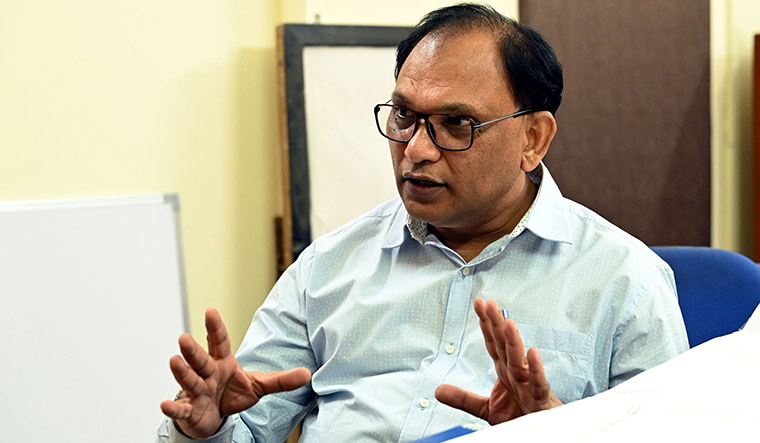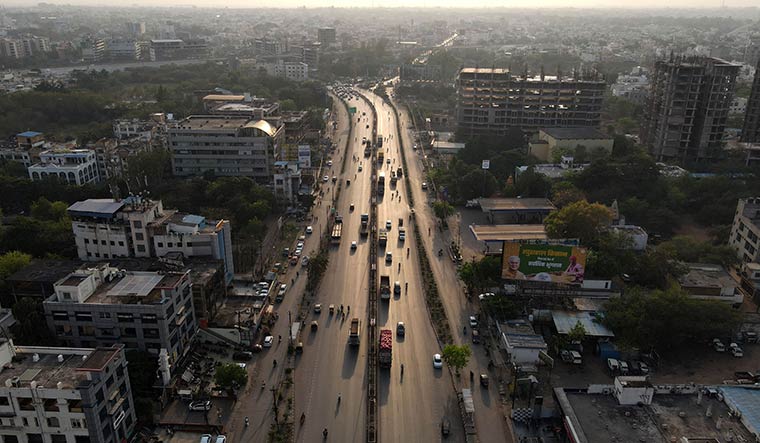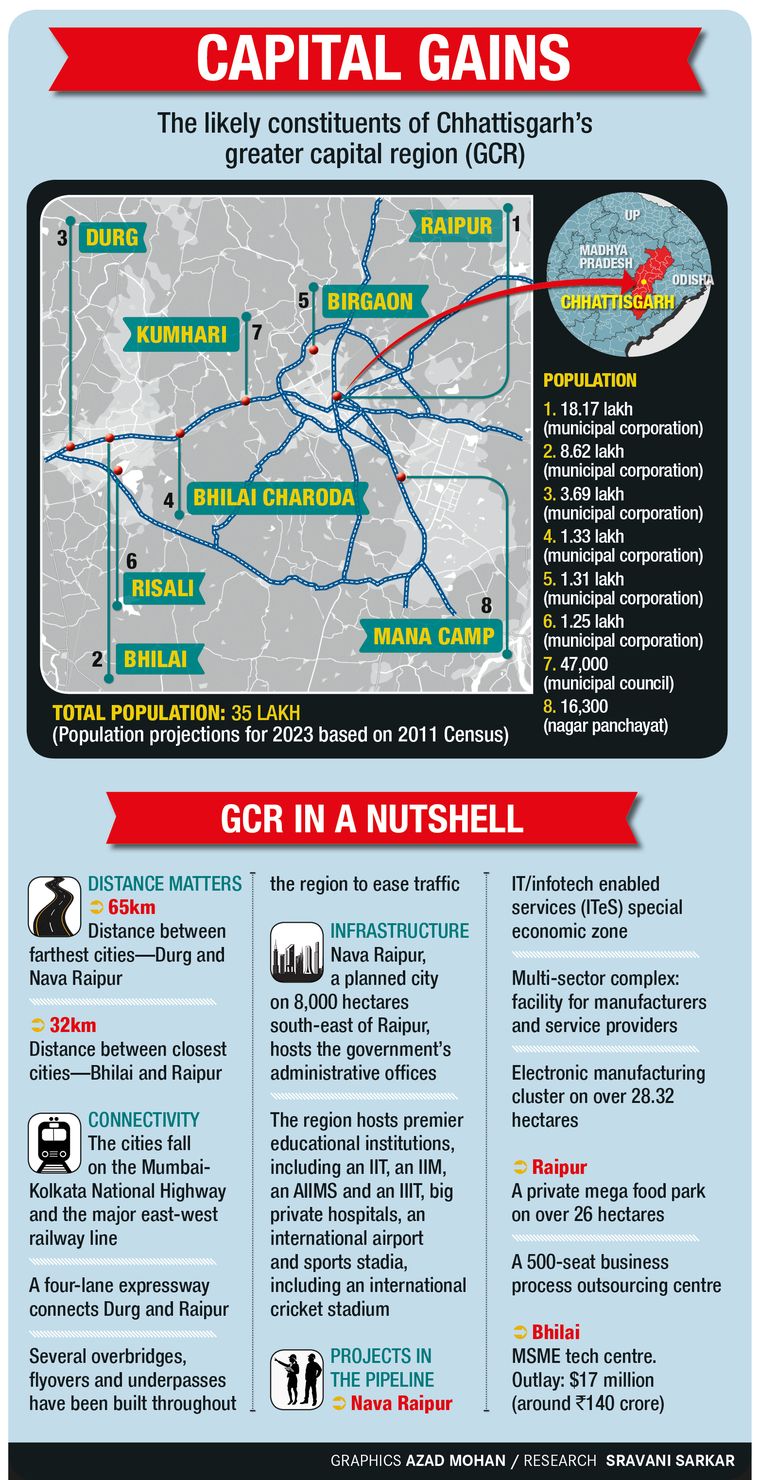Blink and you will miss it. As you drive along the 40km-long west-east stretch of NH-53, the boundaries blur and you wonder where Chhattisgarh’s twin cities of Durg-Bhilai end and where its capital Raipur begins. It can prove illusory even to an alert traveller, as it is one long urban sprawl with wide roads, flyovers, commercial establishments, beautified public spaces and, of course, the quintessential city traffic. And, though further ahead, roughly 10km of the 25km stretch between Raipur and the newly developed Atal Nagar-Nava Raipur is not yet fully urbanised, it still seems like you are traversing through a single mega city instead of four different cities. The import of this organic merging of cities was not lost on the government, which hopes to harness the unique potential it offers to come up with a greater capital region (GCR). The government is planning to merge Raipur, including Nava Raipur, with the neighbouring Bhilai, Durg and smaller towns to form a GCR. “The State Planning Commission has already prepared its recommendations in this direction, which are being reviewed,” Chief Minister Bhupesh Baghel told THE WEEK in an exclusive interview.
Once it comes into being, the GCR will not only be the first such mega urban agglomerate in central India, but also only one of its kind outside the metro capitals of Delhi, Mumbai, Kolkata, Chennai, Bengaluru and Hyderabad. This is because the GCR will be based on organic urban clustering of cities and towns in two neighbouring districts in a small state that is still considered to be developing, said experts.
The GCR, according to experts, is a practical proposition as the cities and towns being considered for it fall in a 65km linear stretch. In the two decades since Chhattisgarh was carved out of Madhya Pradesh in 2000, there has been rapid urbanisation in and around Raipur. Nava Raipur was developed with an aim to replace Raipur as the capital. Meanwhile, Raipur along with Nava Raipur organically expanded into Durg and Bhilai. The twin cities were already quite urbanised because of the presence of the iconic Bhilai steel plant and continued to grow when the new state was formed, said Abir Bandopadhyay, professor of architecture at the National Institute of Technology, Raipur, who specialises in urban planning.
Apart from Raipur, Durg and Bhilai, Baghel said that the government plans to include Birgaon and Mana Camp in Raipur district and Risali, Kumhari and Bhilai Charoda in Durg district in the GCR. All of these are governed by municipal corporations, except Mana (nagar panchayat) and Kumhari (municipal council). As per projections based on Census 2011, the region has a collective population of about 35 lakh, thereby constituting more than 40 per cent of the state’s urban population. The Nava Raipur Development Plan (2031), however, puts the estimated population in the belt (within 50km radius of Raipur) at over 38 lakh in 2021. Given the urbanisation trend, the geographical area and the population, the GCR may turn out to be the biggest among cities in central India. Madhya Pradesh’s Indore and Maharashtra’s Nagpur are said to be the biggest urban centres in the region. They have an estimated urban population of 33 lakh and 30.40 lakh, respectively. According to the Nava Raipur Development Plan, the total urban population in the Raipur-Durg-Bhilai belt will be over 55 lakh in 2031; it will be around 40 lakh each for Indore and Nagpur. Moreover, both are non-capital cities and thus have limitations for future growth.
Experts see huge potential in the Raipur GCR. “Although a predominantly rural, forested and tribal state, the young state of Chhattisgarh has potential for industrialisation and concomitant urban development, especially along the Raipur-Durg-Bhilai region, which is linear along the stretch of the Mumbai-Nagpur-Kolkata National Highway and the main railway line,” said Vishwanath Sista, officer on special duty (land pooling), Hyderabad Metropolitan Development Authority (HMDA). “But it will require a proper institutional outfit to implement the development plan, perhaps on the lines of the Delhi National Capital Region.” He added that it may be called the Chhattisgarh State Capital Region and can include planning and development powers and legal instruments like that of the HMDA Act, 2008.
 Building block: The Bhilai steel plant | Salil Bera
Building block: The Bhilai steel plant | Salil Bera
The Congress government in the state seems intent on giving a push to urban development, especially in services and infrastructure domains, along with focusing on the agro-based economy of the state. In the 2023-2024 state budget, Rs5,361 crore was allocated for urban development, more than double the amount in 2022-23. Baghel, who also holds the finance portfolio, announced a light metro service between Durg and Nava Raipur. Also, with a 92km-long six-lane expressway being constructed from Durg to Arang (beyond Raipur) under the Centre’s Bharatmala project, the region’s development will gather pace in the coming years.
Experts, while welcoming the idea of the GCR, also point out some loopholes that need to be plugged in before moving ahead with the mega plan. Sandeep Bangde, chief town planner of Chhattisgarh and chairman of the state chapter of Institute of Town Planners, India (ITPI), said that the most important thing would be to have a metropolitan council that will work as a single coordinating policy-making body, planning agency and provider of essential services for the entire region. “Also, it is important to have a plan for the whole region to be divided into dedicated sectors for different activities like trading, wholesale market, agro-based activities and steel plant-based activities,” he said. “Piecemeal planning will not work and it has to be coordinated by a single agency.” Bangde also emphasised on the need for a bypass road between Durg and Raipur, so that long-distance traffic could be diverted and local transportation made easier. This would also help in coal transportation.
 Sandeep Bangde | Salil Bera
Sandeep Bangde | Salil Bera
Bandopadhyay, who is a former chairman of ITPI, said that while planning a GCR, attention has to be paid to the availability of basic civic amenities and on proper road designing and connectivity. “Currently, even in Raipur, we have no walk-able roads as there are no footpaths on major thoroughfares,” he said. “Also, local mass transport facilities are not available and therefore private vehicles clog the roads.” He also pointed out that one of the reasons why Nava Raipur, a well-planned and beautiful city, failed to replace Raipur as the state capital was because of the lack of connectivity between the old and new capital.
Author Diwakar Muktibodh also underlined the need for connectivity between Raipur and Nava Raipur, and development of markets and services in the planned city. “Many people have purchased houses in Nava Raipur, but are averse to moving there as there are no markets or daily service facilities,” he said. “Even government employees go to the office in Nava Raipur in special buses and return to the old city in the evening. Nava Raipur becomes deserted after office hours. This needs to change.”
Baijendra Kumar N., former chairman of Nava Raipur Development Authority, said that Nava Raipur is the most inclusive, smart, well-planned, greenfield city in India, with great and unlimited potential for organic urban development of the region. “However, the growth and development of Nava Raipur and surrounding towns will depend on political will, proper funding and budget support,” he said. “If starved of funds, the dream city may not be a certainty.”
Citizens, for now, see the GCR as a great opportunity for development. Pallavi Verma, 23, a medical graduate who is preparing for the civil services, said, “This will not only give a boost to the image of Chhattisgarh, but also lots of opportunities for younger people.”
Gaurav Chakraborty, 38, who works with a private firm, said it would give the state a pan-Indian identity. People from other states tend to have preconceived notions of Chhattisgarh being a tribal, rural state that has been fighting Maoists for long. “At present, when I go to, say, Kolkata, people often don’t know about Chhattisgarh and Raipur and we have to give details about its geographic location and specialties,” said Chakraborty. “I am sure this will change if we get such a big, modern capital region with all the facilities.”



